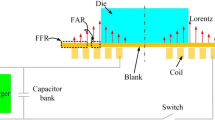Abstract
Electromagnetic forming (EMF) is a high strain rate forming technology which can effectively deform and shape high electrically conductive materials at room temperature. In this study, the electromagnetic and mechanical parts of the process simulated using Maxwell and ABAQUS software, respectively. To provide a link between the software, two approaches include ‘loose’ and ‘sequential’ coupling were applied. This paper is aimed to investigate how sequential coupling would affect radial displacement accuracy, as an indicator of tube final shape, at various discharge voltages. The results indicated a good agreement for the both approaches at lower discharge voltages with more accurate results for sequential coupling, but at high discharge voltages, there was a non-negligible overestimation of about 43% for the loose coupling reduced to only 8.2% difference by applying sequential coupling in the case studied. Therefore, in order to reach more accurate predictions, applying sequential coupling especially at higher discharge voltages is strongly recommended.
Similar content being viewed by others
References
V. Psyk et al., Electromagnetic forming-A review, Journal of Materials Processing Technology, 211 (2011) 787–829.
J. Imbert and M. Worswick, Reduction of a pre-formed radius in aluminum sheet using electromagnetic and conventional forming, Journal of Materials Processing Technology, 212 (2012) 1963–1972.
G. Bartels et al., Comparison of two different simulation algorithms for the electromagnetic tube compression, International Journal of Material Forming, 2 (2009) 693–696.
X. Cui et al., Effect of second current pulse and different algorithms on simulation accuracy for electromagnetic sheet forming, International Journal of Advanced Manufacturing Technology (2013) DOI 10.1007/s00170-013-4906-0.
Y. U. Haiping, L. I. Chunfeng and D. Jianghua, Sequential coupling simulation for electromagnetic-mechanical tube compression by finite element analysis, Journal of Materials Processing Technology, 209 (2012)707-713.
M. M. Nia, Couple simulation of tube electromagnetic forming, M.Sc. Thesis, Amirkabir University of Technology (2012) 25–86.
H.-G. Noh, W.-J. Song, B.-S. Kang and J. Kim, Numerical and experimental approach to reduce bouncing effect in electromagnetic forming process using cushion plate, Journal of Mechanical Science and Technology, 28 (8) (2014) 3263–3271.
R Smerd et al., High strain rate tensile testing of automotive aluminum alloy sheet, International Journal of Impact Engineering, 32 (2005) 541–560.
Y. Murakoshi, M. Takahashi and T. Sano, Inside bead forming of aluminum tube by electro-magnetic forming, Journal of Materials Processing Technology, 80-81 (1998) 695–699.
D. A. Oliveira et al., Electromagnetic forming of aluminum alloy sheet: Free-form and cavity fill experiments and model, Journal of Materials Processing Technology, 170 (2005) 350–362.
Y. J. Choi and O. J. Kwon, Numerical study of effects of accommodation coefficients on slip phenomena, Journal of Mechanical Science and Technology, 29 (5) (2015) 1883–1888.
G. R. Johnson and W. H. Cook, A constitutive model and data for metals subjected to large strains, high strain rates and high temperatures, Proceedings Seventh International Symposium on Ballistics, The Netherlands (1983) 541–548.
X. Fan et al., Dynamic mechanical behavior of 6061 Al alloy at elevated temperature and different strain rates, Acta Mechanica Solida Sinica, 26 (2) (2013) 111–120.
H. E. Haratmeh, Numerical and experimental investigation of wrinkling in inward tube electromagnetic forming, Ph.D. Thesis, Amirkabir University of Technology (2013) 24–87.
D. R. Lesuer, G. J. Kay and M. M. LeBlanc, Modeling large strain, high rate deformation in metals, Third Biennial Tri-Laboratory Engineering Conference Modeling and Simulation, CA (1999) 1–14.
B. M. Corbet, Numerical simulations of target hole diameters for hypervelocity impacts into elevated and room temperature bumpers, International Journal of Impact Engineering, 33 (2006) 431–440.
A. Manes et al., Analysis of strain rate behavior of an Al 6061 T6 alloy, Procedia Engineering, 10 (2011) 3477–3482.
Author information
Authors and Affiliations
Corresponding author
Additional information
Recommended by Associate Editor Jin Weon Kim
Rasoul Chaharmiri received his B.Sc. degree in Metallurgical Engineering from Malek Ashtar University of Technology in 2009. He then took his M.Sc. degree in Mechanical Engineering at Amirkabir University of Technology (Tehran Polytechnic), Iran in 2014. His research interests include the microstructure and mechanical behavior of materials in metallurgical and manufacturing processes.
Alireza Fallahi Arezoodar received his B.Sc. in Metallurgical Engineering from Sharif University of Technology, Iran in 1976. He then took his M.Sc. degree in Metalic and Ceramic Materials form UMIST, UK in 1986 and Ph.D. degree in Metallurgical Engineering from Sheffield University, UK in 1990. He is currently an associate professor in the Department of Mechanical Engineering at Amirkabir University of Technology (Tehran Polytechnic). His research interests include metal forming, metallurgical and manufacturing processes, creep, fatigue and fracture, and physical metallurgy.
Rights and permissions
About this article
Cite this article
Chaharmiri, R., Arezoodar, A.F. The effect of sequential coupling on radial displacement accuracy in electromagnetic inside-bead forming: simulation and experimental analysis using Maxwell and ABAQUS software. J Mech Sci Technol 30, 2005–2010 (2016). https://doi.org/10.1007/s12206-016-0406-0
Received:
Revised:
Accepted:
Published:
Issue Date:
DOI: https://doi.org/10.1007/s12206-016-0406-0



